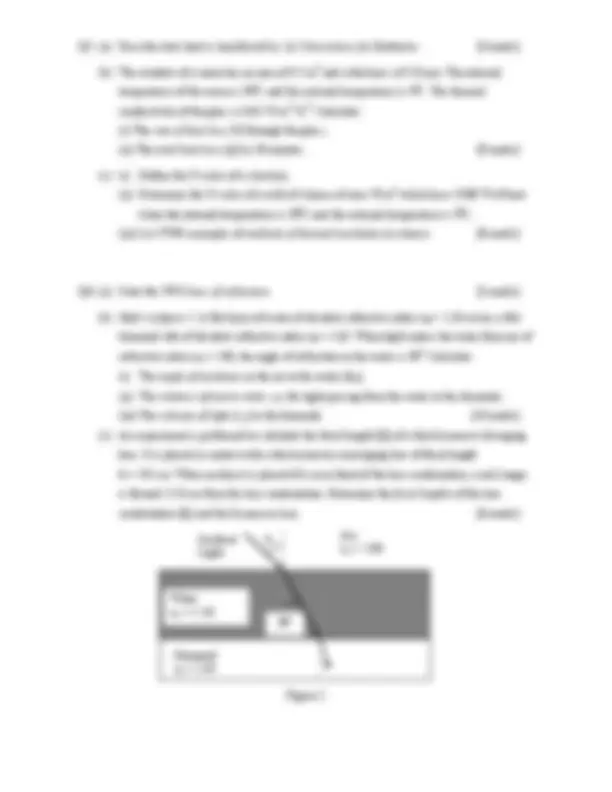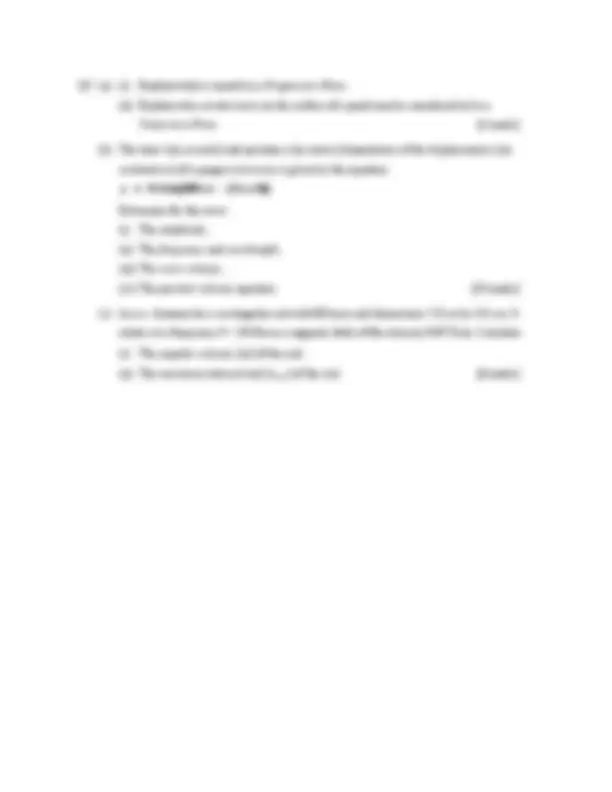




Study with the several resources on Docsity

Earn points by helping other students or get them with a premium plan


Prepare for your exams
Study with the several resources on Docsity

Earn points to download
Earn points by helping other students or get them with a premium plan
Community
Ask the community for help and clear up your study doubts
Discover the best universities in your country according to Docsity users
Free resources
Download our free guides on studying techniques, anxiety management strategies, and thesis advice from Docsity tutors
Main points of this past exam are: Archimedes Principle, Principle of Flotation, Properties of Waves, Interference, Diffraction, Young’s Slits, Diffraction Equation, Bright Fringes, Diffraction Angle, Diffraction Grating
Typology: Exams
1 / 4

This page cannot be seen from the preview
Don't miss anything!



(NFQ Level 8)
Answer FIVE questions only. Show ALL working to gain full marks. Assume: g = 10.0 ms -
Examiners: Prof. P. O Donoghue Mr. T. Corcoran Dr. M. E. Woods
Q1. (a) State: (i) Archimedes Principle ; (ii) The Principle of Flotation [5 marks]
(b) A fisherman of mass m makes a raft of mass M = 500 kg. The raft floats a depth of d 1 = 6.0 cm when initially placed in the water by itself. When the fisherman steps on the raft it sinks a depth of 8.0 cm. What is the mass of the fisherman? [7 marks] (c) A submarine is at a depth H below the surface of the sea of density 1050 kg m-3^. The total surface area of the submarine is 50 m^2. The submarine experiences a pressure of 250 kPa. Calculate: (i) Depth H; (ii) The force F exerted on the hull by the sea. [8 marks]
Q2. (a) Define the following properties of waves: (i) Interference ; (ii) Diffraction. [4 marks] (b) Illustrate diffraction by showing the passage of a plane wave of wavelength λ through an aperture of width d, for which the aperture width is: (i) much larger than the wavelength [d >> λ]; (ii) the same as the wavelength [d = λ]. [4 marks] (c) A monochromatic plane light wave is is incident on Young’s slits. Explain how bright fringes are obtained. Derive the diffraction equation for bright fringes. [6 marks] (d) Yellow light of wavelength 600 nm falls on a diffraction grating with 500 lines per mm. Determine the diffraction angle of the first order diffraction line. State ONE difference in the appearance of the fringes if Young’s slits were used instead of the diffraction grating. [6 marks]
Q3. (a) (i) State Newton’s 2nd Law. (ii) State the equation for limiting static frictional force [Fs]. [4 marks] (b) A box of mass 8.0 kg is placed on a flat rough horizontal surface with static coefficient of friction μs = 0.45 and dynamic coefficient of friction μd = 0.30. Determine the static limiting frictional force F (^) s. Calculate the acceleration a [ if the box moves ] when a horizontal applied force [P] is applied to the box with values: (i) P = 35 N (ii) P = 64 N [8 marks] (c) A train of mass 300 000 kg is travelling up a slope of angle θ = sin-1^ [1/200] with a steady speed of 12.5 ms -1^. The dynamic frictional force is 18 000 N. Determine; (i) The force of the engine [T] to maintain this velocity; (ii) The power [P] of the engine. [8 marks]
Q4. (a) A projectile of mass 4.0 kg is fired with a velocity of 200 ms-1^ at an angle of 30o^ to the horizontal. State or determine the relevant equations and hence calculate: (i) The maximum height reached [H]; (ii) The horizontal component of the velocity [vx] throughout the flight; (iii) The range [R] of the projectile; (iv) The time of flight [T ]. [15 marks] (b) Determine the magnitude and direction of the resultant vector R of vectors a and b shown in figure 1. [5 marks]
Figure 1
Q7. (a) (i) Explain what is meant by a Progressive Wave. (ii) Explain why a water wave on the surface of a pond may be considered to be a Transverse Wave. [4 marks] (b) The time t [in seconds ] and position x [in metres ] dependence of the displacement y [in centimetres ] of a progressive wave is given by the equation: y = 0.4sin[100πt -(3π x/4)] Determine for the wave: (i) The amplitude ; (ii) The frequency and wavelength ; (iii) The wave velocity ; (iv) The particle velocity equation [10 marks] (c) An a.c. dynamo has a rectangular coil with 80 turns and dimensions 5.0 cm by 4.0 cm. It rotates at a frequency f = 250 Hz in a magnetic field of flux density 0.09 Tesla. Calculate: